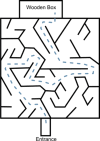No negative effects of intra-abdominal bio-logger implantation under general anaesthesia on spatial cognition learning in a hibernator the edible dormouse
- PMID: 39197002
- PMCID: PMC11356448
- DOI: 10.1371/journal.pone.0307551
No negative effects of intra-abdominal bio-logger implantation under general anaesthesia on spatial cognition learning in a hibernator the edible dormouse
Abstract
The effect of hibernation on cognitive capacities of individuals is not fully understood, as studies provide conflicting results. Most studies focus on behavioural observations without taking the physiological state of individuals to account. To mechanistically understand the effect of hibernation on the brain, physiological parameters need to be included. The implantation of bio-loggers can provide insights on i.e. body temperature without further manipulation of the animals. Surgeries and anaesthesia, however, can harm animals' health and cause cognitive dysfunction, potentially biasing data collected through bio-loggers. We investigated the effects of bio-logger implantation surgery on cognitive performance and learning, controlling for animal and study design characteristics. First, juvenile dormice successfully learned to solve a spatial cognition task using a vertical maze. Distance, transitions, velocity, and duration were measured as indicators for performance. After training, bio-loggers were implanted intra-abdominally under general anaesthesia. Animals were re-tested in the maze two weeks after. We found no effect of bio-logger implantation and surgery on performance. This study is the first to show spatial cognition learning in edible dormice and provides a full description of the peri-anaesthetic management and a protocol for bio-logger implantation surgery in dormice. Importantly, measures were taken to mitigate common anaesthetic complications that could lead to post-operative cognitive dysfunction and influence animal behaviour. By pairing physiological measurements through bio-logger implantation with behaviour and cognition measurements, future research will significantly advance the understanding on mechanisms of learning and behaviour.
Copyright: © 2024 Lammert et al. This is an open access article distributed under the terms of the Creative Commons Attribution License, which permits unrestricted use, distribution, and reproduction in any medium, provided the original author and source are credited.
Conflict of interest statement
The authors declare no competing or financial interests.
Figures




References
-
- Rolland E, Trull S. Spatial mapping memory: methods used to determine the existence and type of cognitive maps in arboreal mammals. Mammal Review. 2022;52: 96–111. doi: 10.1111/mam.12272 - DOI
MeSH terms
LinkOut - more resources
Full Text Sources

